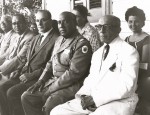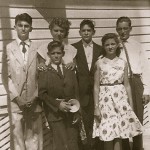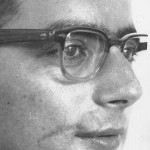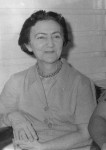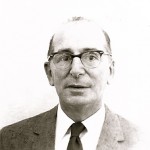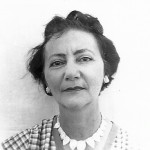| Rudolf Herzberg: | Born in Berlin, Germany June 4, 1898 Deceased in Woodcliff Lake, NJ February 24, 1978 |
| Ilse Herzberg nee Loewenthal: | Born in Berlin, Germany October 2, 1908 Deceased in Sosúa, August 8, 1972 |
Children: Denny
Grandchildren: Unknown
FAMILY STORY
Rudolf and Ilse were born in Berlin to middle-class families. The Herzbergs were lumber dealers, while Ilse’s father was a physician. Rudolf was able to go to college and became an attorney, while Ilse owned a haberdashery store in Berlin. Both loved Berlin, the place they would have never left. They enjoyed going to the theater and to concerts as well as taking long walks through the parks. Rudolf and Ilse met in Berlin, and were married in 1933. Their only child Denny was born in January 1939.
As life started to get more difficult for Jews in Europe, Ilse and Rudolf became aware of the need to leave their beloved country. One day Ilse got a phone call from her sister, saying to her that it’s a beautiful day, take a walk to the park with the baby. My mother did not understand until her sister became more adamant (phones were tapped for Jews), so she took her baby out immediately from the apartment they lived in and shortly thereafter the Gestapo picked up all the Jews on the street. After this event it was imminent to leave Europe. First they tried to get into Israel (then Palestine) and to England, where Dr. Idel Schubert, the sister of Ilse Herzberg, lived, but it was impossible. Then they heard about the Dominican Republic and the resolution of the Evian Conference. Rudolf signed up for agricultural camp training with the Jewish Joint to qualify, a condition required to get a visa. He was selected leader of the first group, one of the very few married couples selected, as Trujillo wanted mostly single men.
Because Rudolf and Ilse had visas to leave Germany, they were able to travel by train to Genova, Italy. Luckily the family was able to leave Europe with a group of 28 persons departing on board the ocean liner Conte Biancamano on April 10, 1940. While they were in line to board the ship at the port of Genova, the unexpected happened: the Gestapo asked for the baby’s visa, which they did not have. Rudolf and Ilse only had their own passports. The Gestapo said to them that the baby had to stay behind until after the war. Rudolf, not accepting this and the departure was still a few hours away, took baby Denny behind a building or structure, opened the only suitcase they had, dumped some cloth out, made a hole in the suitcase with a rock, taped the baby’s mouth and placed him in the suitcase until they were on board the ship. Rudolf, Ilse and baby Denny were in steerage class (today it’s called 3rd class accommodations), together with the rest of the 28 survivors en route to Sosúa. They had limited food; most of the time it was potatoes. Once in a while someone in first class who knew of a baby on board sent an apple down.
The trip from Santo Domingo to Sosúa by bus took 11 hours, as roads, as we know them today, were nonexistent. Upon arrival in Sosúa, the family was placed in a barrack in the Batey, shared with 14 other persons. These arrangements for all settlers who arrived on the first ship and the ships to follow during the 1940s were arranged and funded by the Jewish Joint of N.Y., which was called the DORSA. This was temporary housing, until the houses under construction in Laguna and Bombita were completed one by one.
Denny vividly remembers:
We first lived in the Batey for a short time with many others. We had an outhouse, and one light bulb. Then we moved to the farm house in Laguna, where we got a few dairy cows, some chickens and some pigs. I remember vividly we had an outhouse, and one light bulb. Jacob Weinberg and his family were our neighbors to the right, and Martin Springer with his wife Ilse were our neighbors to the left. Nearby in Laguna lived the Hirschfeld, Levy, Benjamin, DeVries, and Tauber families. When I first went to school, my mother took me on the horse and I remember the horse lying down with colic and we had to jump off. Thereafter in elementary school (Escuela Cristobal Colon) I rode my own horse, which during classes had to be separated at times from the other horses as they kicked one another. Later on I remember a wagon pulled by horses which was driven by Joshi Arm. Finally in 1948 we got our first school bus, a 1948 Chevrolet which was driven at times by Joshi Milz and thereafter by Erich Benjamin. We were about 60 kids at the height of Sosúa’s school population. I remember Dr. Haber our Hebrew teacher, Dr. Robitschek, Hella Blum, and our beloved principal Desiderio Scheer, who in many ways gave us the foundation for life under the melting pot and circumstances Sosúa represented to all of us children. In later years Mr. Hess became the principal. I had already moved on. High school I did in Puerto Plata at the Liceo Secundario Jose Dubeau. We were 3 Jewish kids from Sosúa (“los Judios de Sosúa,” as they called us) – Hermann Strauss, Freddy Rothenberg and I. We stayed at a pension with the Miller family. My parents, after high school, wanted me to get a higher education. They sent me to Cheshire Academy in Cheshire, Connecticut where I repeated my last year of high school in order to learn English before going on to the University of Miami to get my degree in Business Administration.
I had very few Dominican friends. My parents, because of culture differences and language limitations, stuck to the Sosúa immigrant residents. One of my close Dominican friends was Danilo Llibre, whose parents Don Lorenzo Llibre and his family took me in with great hospitality when I visited. I clearly remember the main language in Sosúa was German, and we even had a German written newspaper. For all of us in Sosúa – on the streets, at the Restaurant Oasis, at the Colmado, in the Hotel Garden City – the predominant language among the immigrants was German. In Sosúa we had many cultural activities, classical concerts, opera performances, and most of all I remember the Purim and Hanukkah performances on stage in one of the barracks.
We had a piano at home, and my mother was a fanatic classical piano player until one day out of the blue, when I came home for the weekend from Puerto Plata, the piano was gone. Until her last breath of life, never did she tell us why. Spanish was a new and second language, which some mastered quicker than others. My parents never did but they got by, and it was always foreign to them. My father always read his books and poetry in German and read to me and my mother Faust, Goethe and Heinrich Heine. I remember having to sit while my father read to us poetry in Latin (of which I understood none.) On weekends he would play his Victrola (I still have it) with size 78 classic music records.
Life in Sosúa in those early years was pleasant. I remember walking to the synagogue on Friday evening with my parents and others who lived in Laguna. The Polish immigrants set the religious policies, quite strict: all prayer books in Hebrew, and men and women had separate seating in the synagogue. I remember the Purim and Chanukah plays we put on. Once in a while the DORSA organized meetings with all Sosúans, which were held regularly in the buildings behind the Casa Grande. As a kid, it was special for my parents on weekends to go spend an evening at the Hotel Garden City. There was good food, outdoor ambiance looking out at the Sosúa Bay, and I remember the dancing of the adults. I remember those times very, very fondly; they were fun and something to do.
On the weekends quite regularly we had either concerts or opera put together by our own Sosúa residents. At times guest visitors were brought in by the Jewish Joint. Mrs. Kibel gave multiple piano concerts. Also the residents of Sosúa put on plays. We had our movie house which was run by Felix Koch, an experience in itself, as the reels would continuously break. We sat in the dark until it got spliced and taped back together. It was in the movies that we got the only news, and prior to the beginning of the movie, they showed a news reel. The only other source of world news was from the shortwave radios everyone had and El Caribe newspaper, the only national newspaper of those days. Mr. Rothenberg played his shortwave radio so loud, he covered the entire street with the Deutsche Welle.
In 1963 I got married to Deanne (Kessler maiden name) at a small synagogue in Belleville, Illinois. We immediately moved to Santo Domingo where I worked for several years for the Dominican government, while Deanne taught at the Carol Morgan School. Sosúa leaders wanted me to return to Sosúa and start working with the CILCA and Ganadera on a managerial level. Sadly, it didn’t work out due to economic restraints, although my heart was with Sosúa.
In 1965 the Dominican Revolution broke out, and the family decided to move to the United States, first to Illinois, then New Jersey and now residing in Piermont, New York. Weekends are spent in the Catskills, the Belleayre Music Conservatory, and the B’nai Israel Synagogue in Fleischmanns, New York.
The synagogue, built early in the 1900s, has an enormous similarity to the Sosúa synagogue. Micky Degen, a former Sosúa resident, and Cantor Schreiner (brother of Ernie Schreiner) were very active in the temple.
Rudolf was a group leader of not only the first group to arrive in Sosúa in 1940, but for years to come. He worked very closely with Mr. Rosenberg, Willy Baum, Alfred Rosenzweig, Mr. Blackwood and others to get the infrastructure in place for the settlers who had already arrived but also for those to come from Germany, Austria, Poland, the Shanghai Ghetto, Switzerland and other countries. Besides having to settle all these immigrants into their farms (a kibbutz system which in later years became like a moshav system), the leaders of the community had to deal with cultural differences. It was never understood why they did this, but most Germans were settled in Laguna and Bombita, the Austrians in Atravesada, and so on. Rudolf became President of the CILCA (Cooperativa Industrial Lechera C. por A.), the Ganadera and the Caja de Ahorros y Prestamos (the local cooperative bank set up for the Sosúa settlers). He was also the president of the Sosua synagogue, Parroquia Israelita, and in later years was given the honor of being president of the synagogue in Santo Domingo.
Rudolf Herzberg passed away in Woodcliff Lake, New Jersey and has a memorial stone next to his wife Ilse, who is buried in the Sosúa cemetery.
PHOTO GALLERY
© Copyright Protected

